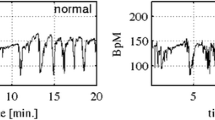Abstract
Fetal heart rate (fHR) is used to evaluate the fetal well-being during the delivery. It provides information of fetal status and allows doctors to detect ongoing hypoxia. Routine clinical evaluation of intrapartal fHR is based on description of macroscopic morphological features of its baseline. In this paper we show, that by using additional features for description of the fHR recordings, we can improve the classification accuracy. Additionally since results of automatic signal evaluation are easily reproducible we can objectify the whole process, thus enabling us to focus on the underlying reasons for high expert inter-observer and intra-observer variability.
Access this chapter
Tax calculation will be finalised at checkout
Purchases are for personal use only
Preview
Unable to display preview. Download preview PDF.
Similar content being viewed by others
References
Steer, P.J.: Has electronic fetal heart rate monitoring made a difference. Seminars in Fetal and Neonatal Medicine 13, 2–7 (2008)
FIGO. Guidelines for the use of fetal monitoring. International Journal of Gynecology & Obstetrics 25, 159–167 (1986)
Blix, E., Sviggum, O., Koss, K.S., Oian, P.: Inter-observer variation in assessment of 845 labour admission tests: comparison between midwives and obstetricians in the clinical setting and two experts. In: BJOG, Nordic School of Public Health, Gothenburg, Sweden, vol. 110(1), pp. 1–5 (2003)
Bernardes, J., Costa-Pereira, A., de Campos, D.A., van Geijn, H.P., Pereira-Leite, L.: Evaluation of interobserver agreement of cardiotocograms. Int. J. Gynaecol Obstet, epartamento de Ginecologia e Obstetrícia, Hospital de S. Jo?o, Faculdade de Medicina do Porto, Oporto, Portugal 57(1), 33–37 (1997)
Bernardes, J., Moura, C., de Sa, J.P., Leite, L.P.: The Porto system for automated cardiotocographic signal analysis. J. Perinat. Med. 19(1-2), 61–65 (1991)
Guijarro-Berdinas, B., Alonso-Betanzos, A., Fontenla-Romero, O.: Intelligent analysis and pattern recognition in ctg signals using a tightly coupled hybrid system. Artif. Intell. 136, 1–27 (2002)
Magenes, G., Pedrinazzi, L., Signorini, M.G.: Identification of fetal sufferance Intepartum through a multiparametric analysis and a support vector machine. In: Conf. Proc. IEEE Eng. Med. Biol. Soc., Dipartimento di Informatica e Sistemistica, Pavia Univ., Italy, vol. 1, pp. 462–465 (2004)
Goncalves, H., Rocha, A.P., Ayres-de Campos, D., Bernardes, J.: Linear and nonlinear fetal heart rate analysis of normal and acidemic fetuses in the minutes preceding delivery. Med. Bio. Eng. Comput. 44, 847–855 (2006)
Laar, J., Porath, M.M., Peters, C.H.L., Oei, S.G.: Spectral analysis of fetal heart rate variability for fetal surveillance: review of the literature. Acta Obstet. Gynecol. Scand. 87(3), 300–306 (2008)
Georgoulas, G., Stylios, C.D., Groumpos, P.P.: Feature extraction and classification of fetal heart rate using wavelet analysis and support vector machines. International Journal on Artificial Intelligence Tools 15, 411–432 (2005)
Hopkins, P., Outram, N., Löfgren, N., Ifeachor, E.C., Rosén, K.G.: A comparative study of fetal heart rate variability analysis techniques. Conf. Proc. IEEE Eng. Med. Biol. Soc. 1, 1784–1787 (2006)
Georgoulas, G., Stylios, C.D., Groumpos, P.P.: Predicting the risk of metabolic acidosis for newborns based on fetal heart rate signal classification using support vector machines. IEEE Trans. Biomed. Eng., Laboratory for Automation and Robotics 53(5), 875–884 (2006)
Sundstrom, A., Rosen, D., Rosen, K.: Fetal surveillance - textbook, Gothenburg
Cao, L.: Practical method for determining the minimum embedding dimension of a scalar time series. Physica D 110, 43–50 (1997)
Task-Force. Heart rate variability. Standards of measurement, physiological interpretation, and clinical use. Task force of the european society of cardiology and the north american society of pacing and electrophysiology. Eur. Heart J. 17(3), 354–381 (1996)
Fraser, A.M., Swinney, H.L.: Independent coordinates for strange attractors from mutual information. Physical Review A 33(2), 1134–1140 (1986)
Esteller, R., Vachtsevanos, G., Echauz, J., Lilt, B.: A comparison of fractal dimension algorithms using synthetic and experimental data. In: Proceedings of the 1999 IEEE International Symposium on Circuits and Systems, ISCAS 1999, vol. 3, pp. 199–202 (1999)
Peng, C.K., Havlin, S., Stanley, H.E., Goldberger, A.L.: Quantification of scaling exponents and crossover phenomena in nonstationary heartbeat time series. Chaos 5, 82–87 (1995)
Pincus, S.: Approximate entropy (ApEn) as a complexity measure. Chaos 5(1), 110–117 (1995)
Pincus, S.M., Viscarello, R.R.: Approximate entropy: a regularity measure for fetal heart rate analysis. Obstet. Gynecol. 79(2), 249–255 (1992)
Lempel, A., Ziv, J.: On the complexity of finite sequences. IEEE Transactions on Information Theory, IT 22(1), 75–81 (1976)
Ferrario, M., Signorini, M.G., Cerutti, S.: Complexity analysis of 24 hours heart rate variability
Witten, I.H., Frank, E.: Data Mining: Practical machine learning tools and techniques, 2nd edn. Morgan Kaufmann, San Francisco (2005)
Author information
Authors and Affiliations
Editor information
Editors and Affiliations
Rights and permissions
Copyright information
© 2010 Springer-Verlag Berlin Heidelberg
About this paper
Cite this paper
Chudáček, V. et al. (2010). Automatic Classification of Intrapartal Fetal Heart-Rate Recordings – Can It Compete with Experts?. In: Khuri, S., Lhotská, L., Pisanti, N. (eds) Information Technology in Bio- and Medical Informatics, ITBAM 2010. ITBAM 2010. Lecture Notes in Computer Science, vol 6266. Springer, Berlin, Heidelberg. https://doi.org/10.1007/978-3-642-15020-3_5
Download citation
DOI: https://doi.org/10.1007/978-3-642-15020-3_5
Publisher Name: Springer, Berlin, Heidelberg
Print ISBN: 978-3-642-15019-7
Online ISBN: 978-3-642-15020-3
eBook Packages: Computer ScienceComputer Science (R0)




